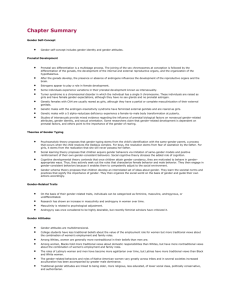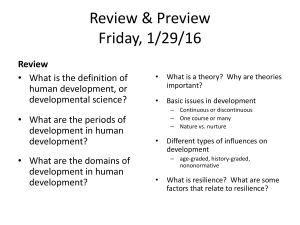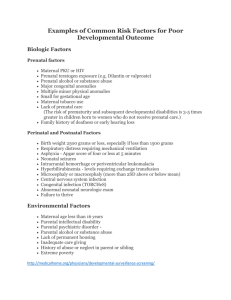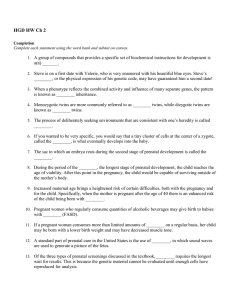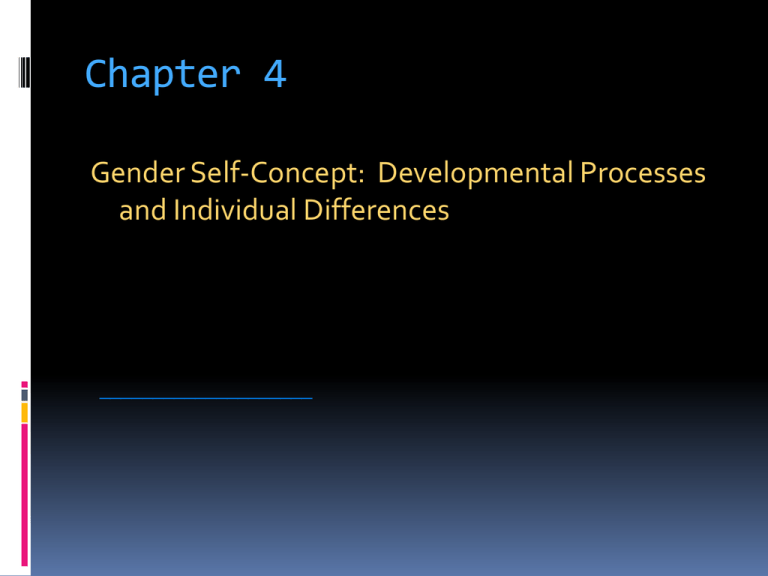
Chapter 4
Gender Self-Concept: Developmental Processes
and Individual Differences
____________________
Gender Self-Concept
Gender identity: One’s self-definition as female
or male
Most people establish a gender identity consistent with their
external reproductive organs
Across gender identity, people vary in their gender attitudes:
beliefs about the appropriate traits, interests, behaviors, and
roles of females and males
______________________
Theories of Gender Typing
Gender typing: the acquisition of the traits,
behaviors, and roles that are generally
associated with one’s gender
_____________________
Theories of Gender Typing
Psychoanalytic theory (Sigmund Freud): gender
typing stems from children’s awareness of
anatomical differences between females and
males combined with their strong inborn
sexual urges
Oedipus complex
Castration anxiety
Identification
Penis envy
_____________________
Theories of Gender Typing
Social learning theory (BF Skinner , Walter
Mischel, Albert Bandura): children acquire
behaviors associated with their gender
because associated with positive
reinforcement or punishment OR those
behaviors are more likely to be imitated.
Reinforcement and punishment
Observational learning (Social cognitive theory)
_____________________
Theories of Gender Typing
Cognitive developmental theory (Lawrence
Kohlberg): Children are active learners,
attempting to make sense of the social
environment
Gender constancy: the belief that gender is permanent
regardless of changes in age, behavior, or appearance
_____________________
Theories of Gender Typing
Gender schema theory (Sandra Bem)
Children develop an interrelated set of ideas (schema) about
gender that guides their social perceptions and actions
Gender schema development stems from learning the gender
norms and practices of society
Individuals vary in the extent to which they use gender
schemas to understand and evaluate others and to guide their
own behavior
_____________________
Prenatal Development
Prenatal sex differentiation: The biological
processes that influence the making of our
physical sex
_____________________
Prenatal Development
Stages of prenatal sex differentiation
Chromosomes
Gonadal development
Androgens
Estrogens
Development of internal reproductive organs
External genitalia
Brain differentiation
_____________________
Prenatal Development
Prenatal Development
Prenatal Development
Intersexuality: The intermingling of
female and male sexual
characteristics
Congenital Adrenal Hyperplasia (CAH)
_____________________
Prenatal Development
Turner syndrome
1/3000 females
Single X
chromosome
(XO) : small,
unable to
reproduce,
stubby fingers,
webbed neck
Prenatal Development
Klinefelter’s syndrome
1/200 males
XXY: Sterility,
feminine traits
Prenatal Development
Androgen-
insensitivity
syndrome
Born XY
Inability of
receptors to
receive
testosterone
Prenatal Development
5 alpha-reductase and 17beta-hydroxysteroid
dehydrogenase deficiency
“guevedoces”
Prenatal Development
Development of intersexuality
Effects of prenatal hormones on gender-related interests and
activities
Prenatal experiences and gender of rearing
Sexual orientation
Research challenges
_____________________
Prenatal development
The John/Joan Case
David Reimer “As Nature Made Him”
Transgender (Gender Identity Disorder)
Gender-Related Traits
Individuals vary in the extent to which they
conform to stereotyped expectations about
their gender
Femininity
Masculinity
Androgyny
Undifferentiation
_____________________
Gender-Related Traits
Changes in gender-related traits over time
Women’s scores on masculinity have increased since the
1970s.
Young women today are more likely than their counterparts
in the 1970s to have experienced and been encouraged
toward roles that involve male-stereotyped characteristics
_____________________
Gender-Related Traits
Gender-related traits and psychological
adjustment
Research demonstrates that positive aspects of masculinity
(e.g., independence, mastery) are associated with positive
psychological well-being
Male-related traits are more highly valued in North American
society
_____________________
Gender Attitudes
People differ in the extent to which they believe
that gender should dictate females’ and males’
roles
Traditional gender attitude: the belief that females should
engage in communal behaviors and roles and males should
engage in agentic behaviors and roles
Nontraditional or egalitarian gender attitude: the belief that
behaviors and roles should not be gender specific
_____________________
What do you think?
Should gender dictate roles?
_____________________
What are your gender
attitudes?
On a scale from 1 (strongly agree) to 7 (strongly
disagree), indicate the degree to which you agree or
disagree with the following statements:
1. The husband should be the head of the family
2. Keeping track of a child’s out-of-school activities should be mostly
3.
4.
5.
6.
7.
8.
9.
the mother’s responsibility
Home economics courses should be as acceptable for male students
as for female students
A person should generally be more polite to a woman than to a man
It is more appropriate for a mother rather than a father to change
their baby’s diaper
It is wrong for a man to enter a traditionally female career
Things work out best in a marriage if a husband leaves his hands off
domestic tasks
Women can handle pressures from their jobs as well as men can
Choice of college is not as important for women as for men
_____________________
Gender Attitudes
Perceived value of female versus male genderrelated attributes
College students associate more advantages with being male
than being female
Advantages and disadvantages associated with each gender
_____________________
Gender Attitudes
Males who violate gender expectations are
evaluated more negatively than females
Social status hypothesis: because the male gender role is
more highly valued than the female role is, a male is seen as
lowering his social status by engaging in female-stereotypic
behaviors, whereas a female performing male-stereotypic
behaviors is perceived as raising hers
Sexual orientation hypothesis: cross-gender behavior in
boys but not girls is considered a sign of actual or potential
same-sex sexual orientation
_____________________


